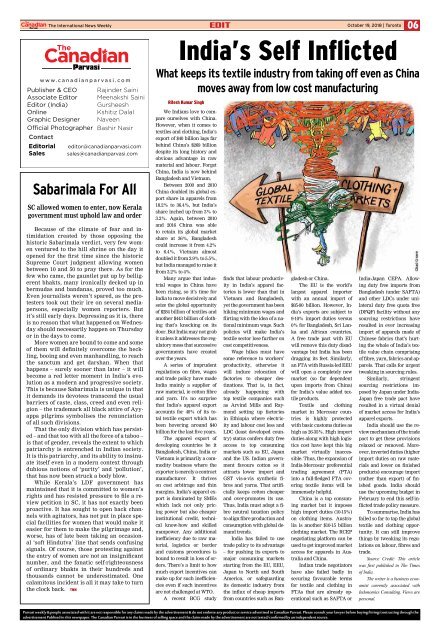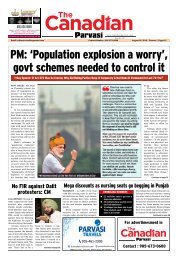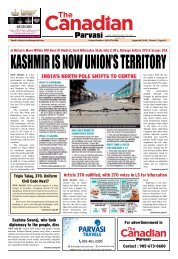Create successful ePaper yourself
Turn your PDF publications into a flip-book with our unique Google optimized e-Paper software.
<strong>The</strong> International News Weekly Edit<br />
06<br />
October 19, 2018 | Toronto<br />
<strong>The</strong><br />
w w w . canadianparv asi. c o m<br />
Publisher & CEO<br />
Associate Editor<br />
Editor (India)<br />
Online<br />
Graphic Designer<br />
Official Photographer<br />
Contact<br />
Editorial<br />
Sales<br />
Rajinder Saini<br />
Meenakshi Saini<br />
Gursheesh<br />
Kshitiz Dalal<br />
Naveen<br />
Bashir Nasir<br />
editor@canadianparvasi.com<br />
sales@canadianparvasi.com<br />
Sabarimala For All<br />
SC allowed women to enter, now Kerala<br />
government must uphold law and order<br />
Because of the climate of fear and intimidation<br />
created by those opposing the<br />
historic Sabarimala verdict, very few women<br />
ventured to the hill shrine on the day it<br />
opened for the first time since the historic<br />
Supreme Court judgment allowing women<br />
between 10 and 50 to pray there. As for the<br />
few who came, the gauntlet put up by belligerent<br />
bhakts, many ironically decked up in<br />
bermudas and bandanas, proved too much.<br />
Even journalists weren’t spared, as the protesters<br />
took out their ire on several mediapersons,<br />
especially women reporters. But<br />
it’s still early days. Depressing as it is, there<br />
is no reason that what happened on Wednesday<br />
should necessarily happen on Thursday<br />
or in the days to come.<br />
More women are bound to come and some<br />
of them will definitely overcome the heckling,<br />
booing and even manhandling, to reach<br />
the sanctum and get darshan. When that<br />
happens – surely sooner than later – it will<br />
become a red letter moment in India’s evolution<br />
as a modern and progressive society.<br />
This is because Sabarimala is unique in that<br />
it demands its devotees transcend the usual<br />
barriers of caste, class, creed and even religion<br />
– the trademark all black attire of Ayyappa<br />
pilgrims symbolises the renunciation<br />
of all such divisions.<br />
That the only division which has persisted<br />
– and that too with all the force of a taboo –<br />
is that of gender, reveals the extent to which<br />
patriarchy is entrenched in Indian society.<br />
It is this patriarchy, and its ability to insinuate<br />
itself even in a modern context through<br />
dubious notions of ‘purity’ and ‘pollution’,<br />
that has now been struck a body blow.<br />
While Kerala’s LDF government has<br />
maintained that it is committed to women’s<br />
rights and has resisted pressure to file a review<br />
petition in SC, it has not exactly been<br />
proactive. It has sought to open back channels<br />
with agitators, has not put in place special<br />
facilities for women that would make it<br />
easier for them to make the pilgrimage and,<br />
worse, has of late been taking an occasional<br />
‘soft Hindutva’ line that sends confusing<br />
signals. Of course, those protesting against<br />
the entry of women are not an insignificant<br />
number, and the fanatic self-righteousness<br />
of ordinary bhakts in their hundreds and<br />
thousands cannot be underestimated. One<br />
calamitous incident is all it may take to turn<br />
the clock back. TNN<br />
India’s Self Inflicted<br />
What keeps its textile industry from taking off even as China<br />
moves away from low cost manufacturing<br />
Ritesh Kumar Singh<br />
We Indians love to compare<br />
ourselves with China.<br />
However, when it comes to<br />
textiles and clothing, India’s<br />
export of $40 billion lags far<br />
behind China’s $269 billion<br />
despite its long history and<br />
obvious advantage in raw<br />
material and labour. Forget<br />
China, India is now behind<br />
Bangladesh and Vietnam.<br />
Between 2000 and 2010<br />
China doubled its global export<br />
share in apparels from<br />
18.2% to 36.4%, but India’s<br />
share inched up from 3% to<br />
3.2%. Again, between 2010<br />
and 2016 China was able<br />
to retain its global market<br />
share at 36%, Bangladesh<br />
could increase it from 4.2%<br />
to 6.4%, Vietnam almost<br />
doubled it from 2.9% to 5.5%,<br />
but India managed to raise it<br />
from 3.2% to 4%.<br />
Many argue that industrial<br />
wages in China have<br />
been rising, so it’s time for<br />
India to move decisively and<br />
seize the global opportunity<br />
of $284 billion of textiles and<br />
another $443 billion of clothing<br />
that’s knocking on its<br />
door. But India may not grab<br />
it unless it addresses the regulatory<br />
mess that successive<br />
governments have created<br />
over the years.<br />
A series of imprudent<br />
regulations on fibre, wages<br />
and trade policy have made<br />
India mainly a supplier of<br />
raw material, ie cotton fibre<br />
and yarn. It’s no surprise<br />
that India’s apparel export<br />
accounts for 40% of its total<br />
textile export which has<br />
been hovering around $40<br />
billion for the last five years.<br />
<strong>The</strong> apparel export of<br />
developing countries be it<br />
Bangladesh, China, India or<br />
Vietnam is primarily a commodity<br />
business where the<br />
exporter is merely a contract<br />
manufacturer. It thrives<br />
on cost arbitrage and thin<br />
margins. India’s apparel export<br />
is dominated by SMEs<br />
which lack not only pricing<br />
power but also cheaper<br />
institutional credit, technical<br />
know-how and skilled<br />
manpower. Any additional<br />
inefficiency due to raw material,<br />
logistics or border<br />
and customs procedures is<br />
bound to result in loss of orders.<br />
<strong>The</strong>re’s a limit to how<br />
much export incentives can<br />
make up for such inefficiencies<br />
even if such incentives<br />
are not challenged at WTO.<br />
A recent BCG study<br />
finds that labour productivity<br />
in India’s apparel factories<br />
is lower than that in<br />
Vietnam and Bangladesh,<br />
yet the government has been<br />
hiking minimum wages and<br />
flirting with the idea of a national<br />
minimum wage. Such<br />
policies will make India’s<br />
textile sector lose further on<br />
cost competitiveness.<br />
Wage hikes must have<br />
some reference to workers’<br />
productivity, otherwise it<br />
will induce relocation of<br />
factories to cheaper destinations.<br />
That is, in fact,<br />
already happening with<br />
top textile companies such<br />
as Arvind Mills and Raymond<br />
setting up factories<br />
in Ethiopia where electricity<br />
and labour cost less and<br />
LDC (least developed country)<br />
status confers duty free<br />
access to top consuming<br />
markets such as EU, Japan<br />
and the US. Indian government<br />
favours cotton so it<br />
attracts lower import and<br />
GST vis-a-vis synthetic fibres<br />
and yarns. That artificially<br />
keeps cotton cheaper<br />
and over-promotes its use.<br />
Thus, India must adopt a fibre<br />
neutral taxation policy<br />
to align fibre production and<br />
consumption with global demand<br />
trends.<br />
India has failed to use<br />
trade policy to its advantage<br />
– for pushing its exports to<br />
major consuming markets<br />
starting from the EU, EEU,<br />
Japan to North and South<br />
America, or safeguarding<br />
its domestic industry from<br />
the influx of cheap imports<br />
from countries such as Bangladesh<br />
or China.<br />
<strong>The</strong> EU is the world’s<br />
largest apparel importer<br />
with an annual import of<br />
$85-90 billion. However, India’s<br />
exports are subject to<br />
9-10% import duties versus<br />
0% for Bangladesh, Sri Lanka<br />
and African countries.<br />
A free trade pact with EU<br />
will remove this duty disadvantage<br />
but India has been<br />
dragging its feet. Similarly,<br />
an FTA with Russia-led EEU<br />
will open a completely new<br />
market (so far dependent<br />
upon imports from China)<br />
for India’s value added textile<br />
products.<br />
Textile and clothing<br />
market in Mercosur countries<br />
is highly protected<br />
with basic customs duties as<br />
high as 26-35%. High import<br />
duties along with high logistics<br />
cost have kept this big<br />
market virtually inaccessible.<br />
Thus, the expansion of<br />
India-Mercosur preferential<br />
trading agreement (PTA)<br />
into a full-fledged FTA covering<br />
textile items will be<br />
immensely helpful.<br />
China is a top consuming<br />
market but it imposes<br />
high import duties (10-15%)<br />
on clothing items. Australia<br />
is another $10-15 billion<br />
clothing market. <strong>The</strong> RCEP<br />
negotiating platform can be<br />
used to get improved market<br />
access for apparels in Australia<br />
and China.<br />
Indian trade negotiators<br />
have also failed badly in<br />
securing favourable terms<br />
for textile and clothing in<br />
FTAs that are already operational<br />
such as SAFTA or<br />
India-Japan CEPA. Allowing<br />
duty free imports from<br />
Bangladesh (under SAFTA)<br />
and other LDCs under unilateral<br />
duty free quota free<br />
(DFQF) facility without any<br />
sourcing restrictions have<br />
resulted in ever increasing<br />
import of apparels made of<br />
Chinese fabrics that’s hurting<br />
the whole of India’s textile<br />
value chain comprising<br />
of fibre, yarn, fabrics and apparels.<br />
That calls for urgent<br />
tweaking in sourcing rules.<br />
Similarly, stringent<br />
sourcing restrictions imposed<br />
by Japan under India-<br />
Japan free trade pact have<br />
resulted in a virtual denial<br />
of market access for India’s<br />
apparel exports.<br />
India should use the review<br />
mechanism of the trade<br />
pact to get these provisions<br />
relaxed or removed. Moreover,<br />
inverted duties (higher<br />
import duties on raw materials<br />
and lower on finished<br />
products) encourage import<br />
(rather than export) of finished<br />
goods. India should<br />
use the upcoming budget in<br />
February to end this self-inflicted<br />
trade policy measure.<br />
To summarise, India has<br />
failed so far to tap the global<br />
textile and clothing opportunity.<br />
It can still improve<br />
things by tweaking its regulations<br />
on labour, fibres and<br />
trade.<br />
Source Credit: This article<br />
was first published in <strong>The</strong> Times<br />
of India.<br />
<strong>The</strong> writer is a business economist<br />
currently associated with<br />
Indonomics Consulting. Views are<br />
personal.<br />
<strong>Parvasi</strong> weekly & people associated with it are not responsible for any claims made by the advertisement & do not endorse any product or service advertised in <strong>Canadian</strong> <strong>Parvasi</strong>. Please consult your lawyer before buying/hiring/contracting through the<br />
advertisement Publised in this newspaper. <strong>The</strong> <strong>Canadian</strong> <strong>Parvasi</strong> is in the business of selling space and the clains made by the advertisement are not tested/confirmed by an independent source.

















